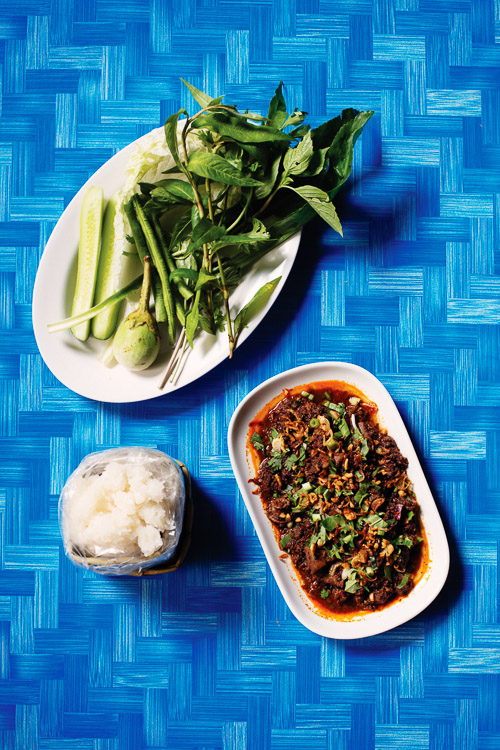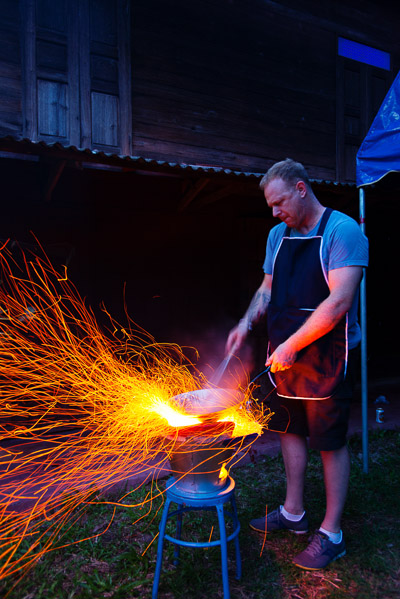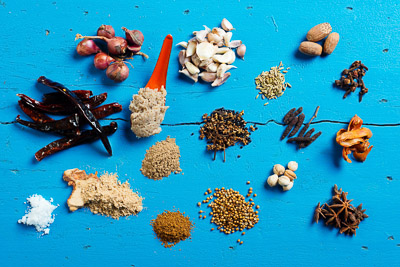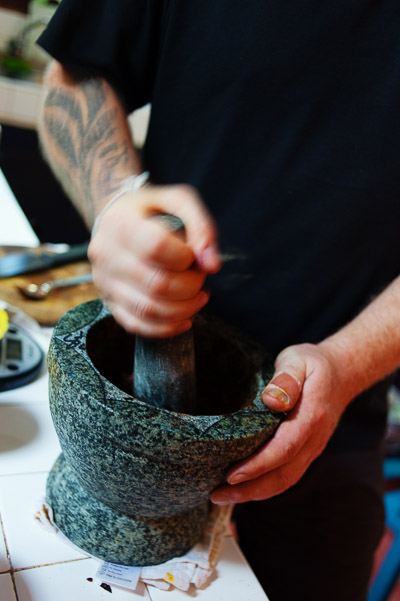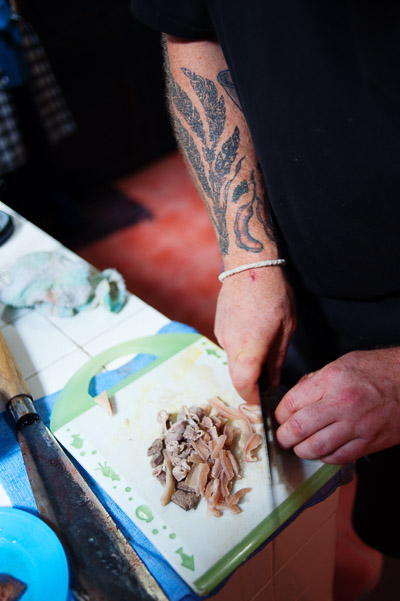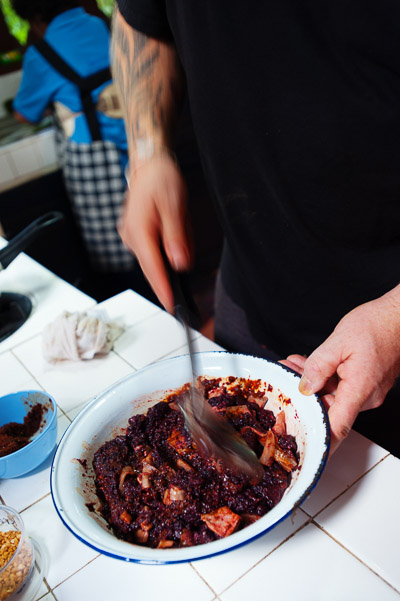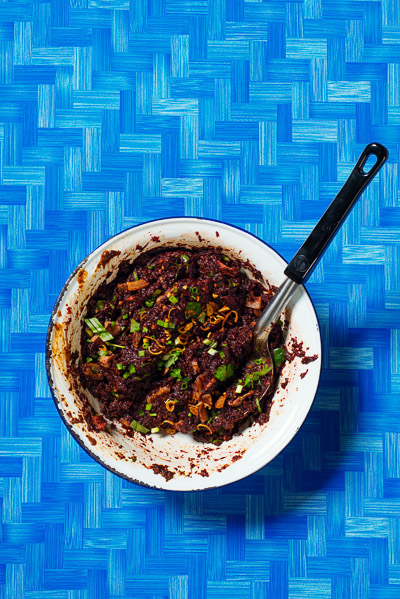In late 2007, I was pointed in the direction of a New York Times piece on the dining scene in my hometown of Portland, Oregon. Among the restaurants highlighted was a place called Pok Pok. Unlike most restaurants in the US doing Thai food, Pok Pok wasn't serving green curry with bell peppers or phad Thai with beef, but rather, stuff that Thai people actually eat: yam khai dao, hearty soups, obscure chili-based 'dips' and other rustic, regional Thai dishes. My interest was piqued, and I shot off an email to the restaurant's chef/owner. He replied almost immediately, and to my surprise, was familiar with the very blog you're reading now. He was coming to Thailand in a few months, and we arranged meet up.
Six years later, that guy and I are friends and collaborators.
I'm terribly excited for Andy's success. Yet I dare say that his soon-to-be-released book, Pok Pok (currently available for pre-order here or here), may endure longer than his restaurants. Simply put, unless you can read Thai, there's no other comparable resource for regional Thai recipes. And best of all they're good, real recipes: Andy learned them from talented home and professional chefs in Thailand, and from decades of eating and cooking across the country, and over the years has subsequently honed them in his restaurants. At this point he's a pro at introducing obscure ingredients and dishes both to diners and to his staff, and it's this unique sensibility and authority that he brings to the book. I recently asked Andy a few questions about the process of writing Pok Pok:
-Many of the recipes in Pok Pok can appear pretty time-consuming and/or involve obscure techniques and ingredients. At the same time it's quite readable and has an engaging narrative flow. Did you approach it as a functional cookbook that people will actually cook from, or more as a reference (or perhaps even entertainment)?
Both; these days cookbooks need to be more than a volume of recipes, they also need to have a story and lots of pretty pictures to sell well. Having said that, it was really important to me that this be a working cookbook, something that you could get dirty.
-For those familiar with Thai food, a glance at the list of recipes alone seems to indicate that Pok Pok doesn't pull any punches. In a general sense, what kind of allowances did you have to make for an American audience?
Very few. Basically, we left out recipes that had ingredients that are hard or impossible to find in the West.
-Are these Thai recipes or your recipes?
These are recipes I have learned over 20 years of traveling, eating and cooking in Thailand. Most are my attempt to make a version of the dish that would be acceptable to the folks who come from the region the dish originates in.
-Quite a few of the recipes have their origins in northern Thailand. What is it about this region's food that appeals to you so much?
It's my first true love when it comes to the food of Thailand. There is just something about the flavor combinations and style of cooking that appeals to me more than any other region's.
-You chose to profile the recipe for northern-style laap. It's also one of my favourite Thai dishes, but at its core it's essentially just minced meat and spice. What is it that's so special about this dish?
To me it is emblematic of the cuisine of northern Thailand. It is highly fetishized in the north, with variations in every province, city, town and even house to house. The way it is eaten, shared with lots of fresh herbs and vegetables along with sticky rice, often alongside beer or booze in a convivial atmosphere is at the core of of how Thai people eat: it's not just what you eat, it's how and (maybe most important) why you eat.
-Any tips for people who want to make it?
Have patience, try it more than once, and do not skip the fresh herbs and vegetables, nor the sticky rice; they are an essential part of the dish.
Laap Meuang/Northern Thai Minced Pork Salad
Reprinted with permission from Pok Pok by Andy Ricker with J.J. Goode, copyright © 2013. Published by Ten Speed Press, a division of Random House, Inc.
Serves 6 to 12 as part of a meal
Naam phrik laap (laap seasoning paste) 1 ounce stemmed dried Mexican puya chilies (about 12) 1 tablespoon makhwaen, black Sichuan peppercorns, or whole black peppercorns 1 tablespoon coriander seeds 1 teaspoon fennel seeds 1/2 teaspoon ground dried galangal 1/2 teaspoon ground dried lemongrass 1/2 teaspoon black peppercorns 1/4 teaspoon cumin seeds 1/8 teaspoon freshly grated nutmeg 4 cloves 2 dried Indonesian long peppers (called pippali in Indian and Malay markets, dippli in Thai markets, tiêu lớp in Vietnamese markets) 1 star anise 1 whole mace 1 cardamom pod, preferably the white, rounder Thai variety 1 teaspoon kosher salt 1 ounce peeled garlic, halved lengthwise 2 ounces peeled Asian shallots, thinly sliced against the grain 1 tablespoon Kapi Kung (Homemade shrimp paste)
Offal 1 ounces pork small intestine, cut into a few pieces 2 ounces pork skin, cut into a few pieces 1 (2-ounce) piece pork liver 1 teaspoon Kapi Kung (Homemade shrimp paste) 1 (14-gram) piece unpeeled fresh or frozen (not defrosted) galangal, coarsely sliced 1 large stalk lemongrass, outer layer removed, halved crosswise, and lightly smashed with a pestle, pan, or flat part of a knife blade 3 1/2 cups water
Pork 1 large stalk lemongrass, outer layer removed, halved crosswise, and lightly smashed with a pestle, pan, or flat part of a knife blade 2 cups fresh or defrosted frozen raw pork blood 1 pound boneless pork loin, trimmed of any large fat deposits if necessary and cut against the grain into approximately 1/2-inch-thick slices
To prepare the laap for cooking 1/2 cup reserved offal cooking liquid 1/2 teaspoon kosher salt 2 tablespoons thinly sliced green onions, lightly packed 2 tablespoons thinly sliced sawtooth herb, lightly packed 2 tablespoons coarsely chopped cilantro (thin stems and leaves), lightly packed 2 tablespoons coarsely chopped Vietnamese mint leaves, lightly packed 2 tablespoons fried shallots 1 tablespoon fried garlic
To serve the laap 2 tablespoons fried-shallot or fried-garlic oil 1 1/2 cups reserved offal cooking liquid 3 tablespoons thinly sliced green onions, lightly packed 3 tablespoons thinly sliced sawtooth herb, lightly packed 3 tablespoons coarsely chopped cilantro (thin stems and leaves), lightly packed 3 tablespoons coarsely chopped Vietnamese mint leaves, lightly packed 3 tablespoons fried shallots 3 tablespoon fried garlic 3 tablespoons very coarsely chopped (about 1/4-inch pieces) unseasoned pork cracklings, preferably with some meat attached
Make the naam phrik laap (laap seasoning paste) Put the chiles in a small dry pan or wok, increase the heat to high to get the pan hot, then decrease the heat to low. Cook, stirring and flipping them frequently to make sure both sides of the chiles make contact with the hot pan, until the chiles are brittle and very dark brown (nearly black) all over, 15 to 20 minutes. Remove the chiles from the pan as they’re finished. (Discard any seeds that escape the chiles, because they’ll be burnt and bitter.) Set the chiles aside.
Combine the makhwen, coriander seeds, fennel seeds, ground galangal, ground lemongrass, black peppercorns, cumin seeds, nutmeg, cloves, long peppers, star anise, mace, and cardamom in a small pan, set the pan over low heat, and cook, stirring and tossing often, until they’re very fragrant, about 5 minutes. Turn off the heat and stir for another minute. Grind them in a spice grinder (or pound them in a granite mortar) to a fairly fine powder.
Combine the dried chiles and salt in a granite mortar and pound firmly, scraping the mortar and stirring the mixture once or twice, until you have a fairly fine powder, about 5 minutes. Add the garlic and pound, occasionally stopping to scrape down the sides of the mortar, until you have a fairly smooth paste, about 2 minutes. Do the same with the shallots. Next, add the ground spice mixture and pound until it’s well incorporated into the paste, about 2 minutes. Finally, pound in the shrimp paste until it’s fully incorporated, about 30 seconds.
You’ll have about 1/2 cup of paste. You can use it right away, or store the paste in the fridge for up to 1 week or in the freezer for up to 6 months. It helps to freeze the paste in small portions. You’ll need about 6 tablespoons of paste for enough laap to serve 6 to 12 people.
Cook the offal Combine the intestines, skin, liver, shrimp paste, galangal, lemongrass, and water in a small pot. Set the pot over high heat and bring the water to a strong simmer. Check the pork liver. Once it’s cooked through (firm and just barely pink in the center), transfer it to a cutting board. Decrease the heat to maintain a gentle but steady simmer, skimming off any surface scum.
Keep cooking until the skin is translucent and soft enough to easily slice, about 20 minutes. Transfer the intestines and skin to the cutting board with the liver and reserve 2 cups of the liquid. When they’re all cool enough to handle, slice the intestines and liver into small bite-size pieces. Slice the skin into thin 2-inch- long strips.
Chop ("laap") the pork Clear your appointments for the next 45 minutes.
Combine the lemongrass and blood in a mixing bowl and use your hand to squeeze and squish the lemongrass stalk for about a minute. You’re helping to release the essence of the lemongrass, which tones down the flavor of the blood and keeps the blood liquid. Leave the lemongrass in the blood for now, but avoid it when you spoon out the blood later.
Put the pork slices on a solid wood chopping block or cutting board. Use a heavy knife or cleaver to chop the pork, lifting the knife off the block with each chop and working methodically from one side of the expanse of meat to the other, then working your way back. (How hard should you chop? Pretend you want to hack a medium-size carrot into two pieces with each chop. Rely on your wrist for motion and the weight of the knife for most of your power.) Every 15 seconds or so, use the knife to scoop up some of the meat and fold it back onto the rest. Make sure you’re not neglecting any spots.
Once the meat is coarsely chopped, after about 5 minutes, drizzle on 2 tablespoons of the blood (leaving behind the lemongrass), and keep chopping and folding as before to incorporate the blood and to continue chopping the meat more and more finely. Keep at it, adding another 2 tablespoons of blood every 5 minutes but stopping once you’ve used a total of 1/2 cup, until the blood is completely incorporated (the meat will be a deep purple reminiscent of beets), and the meat is very finely minced (you’re shooting for a level several times finer than that of store-bought ground meat). After 15 minutes, you’ll have reached hamburger texture. Keep going. It requires about 30 to 40 minutes of chopping, depending on your facility for it.
Discard the rest of the blood. (Don’t worry, blood isn’t expensive.) Transfer the minced meat mixture to a bowl. You’ve just spent more time and expended more energy than most people do preparing and eating an entire meal, so it should go without saying that you don’t want to leave any of your hard-won mince on either the chopping block or your knife. Do, however, discard any waxy fat that might have collected on your knife blade.
Prepare the laap for cooking ("yam" the laap) In a medium mixing bowl, stir together the 1/2 cup of reserved offal cooking liquid with the 1/2 teaspoon of salt and 5 to 7 tablespoons of the laap seasoning paste, depending on how intensely flavored you want the final dish to be, until they’re well mixed. Add all of the raw meat mixture and cooked offal, then stir gently but well. Add the salt, green onions, and herbs, stir well, then add the fried shallots and garlic and stir well.
At this point, the average Northern Thai cook would taste the mixture and adjust the seasoning, adding salt (or less typically in the North, fish sauce) if it isn’t salty enough and more naam phrik laap if it is not spicy or intense enough. If you’re brave, go ahead. (If not, you can season it later, as it cooks.) Raw laap is delicious and rich. Northern Thai men of a certain generation would say it is superior to the cooked version. And I agree.
Cook and serve the laap Heat a wok or large pan over high heat, add the oil, and swirl it in the wok to coat the sides. When the oil begins to smoke lightly, add the meat mixture, stir well, then add 11/2 cups of the reserved offal cooking liquid.
Cook, stirring constantly and breaking up the meat to ensure that it doesn’t clump, until the meat is cooked, the liquid begins to simmer vigorously, and the mix- ture looks slightly soupy as the meat gives up its water, about 5 minutes. Taste and season with more salt or laap seasoning paste.
Keep cooking at a vigorous simmer, stirring often, so the flavors have a chance to meld, about 3 minutes more. Spoon the laap onto a large plate or platter in a low mound. There should be some liquid pooling at the edges. Let it cool to just above room temperature, then sprinkle on the green onions, herbs, fried shallots and garlic, and pork cracklings, and serve.
[Ricker suggests making a meal of laap by serving it with sticky rice and "...fresh herbs on the stem, such as Thai basil, sawtooth, cilantro, and Vietnamese mint (rau ram); and raw vegetables, such as wedges of cabbage, quartered Thai apple eggplant, cucumber spears, and 3-inch lengths of long bean."]












